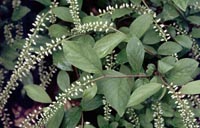Resource Library
Plant of the Week: Virginia Sweetspire (Itea)
The University of Arkansas System Division of Agriculture does not promote, support or recommend plants featured in "Plant of the Week." Please consult your local Extension office for plants suitable for your region.
Plant of the Week
Itea, Virginia Sweetspire
Latin: Itea virginiana

Choosing plants for your landscape can be somewhat bewildering given the thousands
of choices in nurseries.
To help make the choices easier, the Department of Horticulture has teamed up with
the Arkansas Nurseryman’s Association and the Arkansas Greenhouse Growers to identify
plants that will do well across Arkansas. The program, known as Arkansas Select, is
in its third year and has been warmly received by state gardeners.
For 2000, six plants were designated as Arkansas Select winners. They include two
woody shrubs, two perennials and two annuals. Over the next six weeks, I will attempt
to describe these plants in some detail and point out their garden merits.
Landscape styles are changing and Itea fits the new style perfectly. Gone are the days where stiff formality of tightly
pruned balls are the norm. Now the loose and fluffy look is in.
Itea, traditionally considered a member of the Saxifrage family but now being reclassified
weekly as the new taxonomic order takes shape, is a native to the southeastern states
from the Pine Barrens of New Jersey to east Texas.
It has been reported in about half of our Arkansas counties, all the southern or
eastern part of the state. While in the wild it typically is found associated with
moist and even swampy sites, in the landscape it conforms nicely to the moisture regime
of the average garden.
Itea grows 3- to 4-feet tall and spreads horizontally by means of underground stems about
twice its height. It tends to produce ascending branches that often slightly arched
near the tip. Leaves are typically 3 inches long and 1-inch wide and a lustrous green
in the summer. In the fall the leaves turn shades or red, maroon and orange and persist
well past Christmas. The flowers are slightly fragrant and appear in April as white,
pendant bottle-brushes to six inches long.
Two cultivars have been given the nod by the Arkansas Select committee. "Henry’s
Garnet" was the first named selection of Itea, being named only in the 1980s from
a plant growing on the campus of Swarthmore College from seed that had been collected
in Georgia. The seeds were collected by Josephine Henry and garnet is the school color,
hence the name. "Saturnalia" is the second selection highlighted, because of its Arkansas
connection. Larry Lowman, a nurseryman from Wynne, introduced this plant in 1995 from
material he collected while canoeing in Tennessee. It is said to be slightly more
compact than Henry’s Garnet and have yellow orange fall color instead of red.
If you have a control fixation and constantly feel the urge to use hedge shears,
Itea is not for you. But, if you can appreciate gracefully arching branches and an open,
naturalistic look, this shrub is a good choice for massing in the border. It grows
in full sun to medium shade in typical garden soils. Though native to wet areas, it
has good drought tolerance.
In my garden, the planting in a well watered location is 3 feet tall and spreading
rapidly. The planting under a thirsty elm tree is only about half as tall, but holding
its own against an aggressive competitor. No serious disease or insect problems have
been noted.
By: Gerald Klingaman, retired
Extension Horticulturist - Ornamentals
Extension News - April 7, 2000
The University of Arkansas System Division of Agriculture does not maintain lists of retail outlets where these plants can be purchased. Please check your local nursery or other retail outlets to ask about the availability of these plants for your growing area.